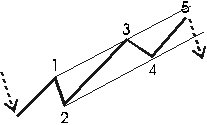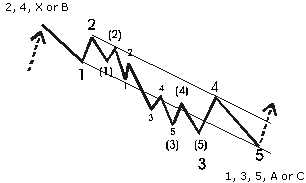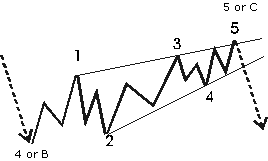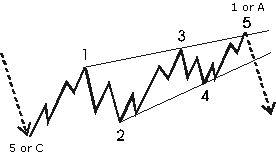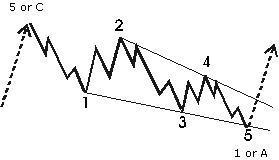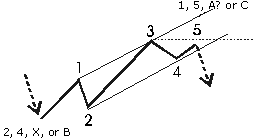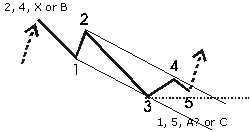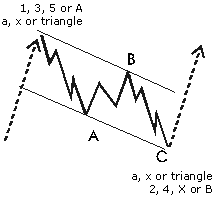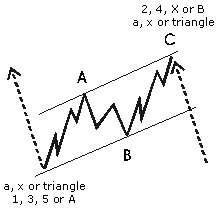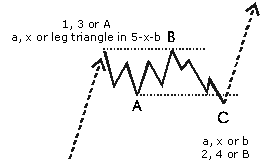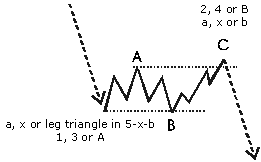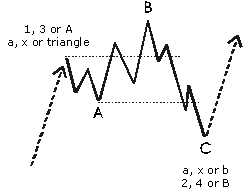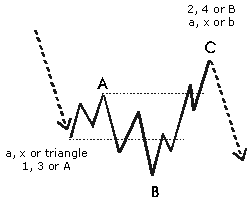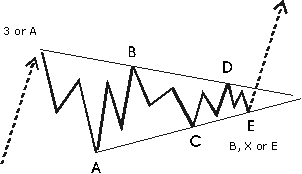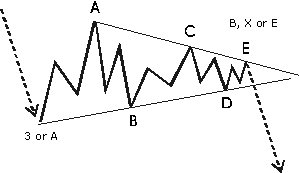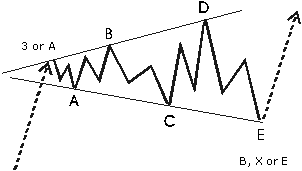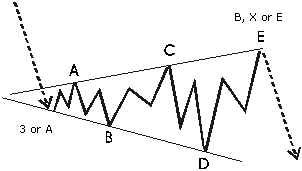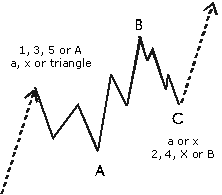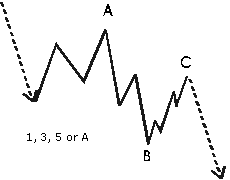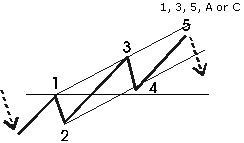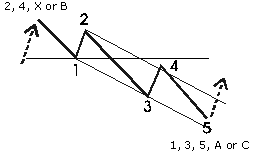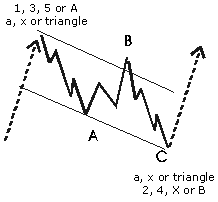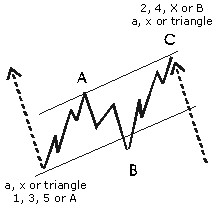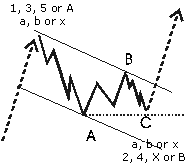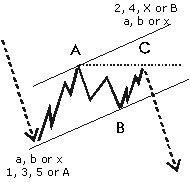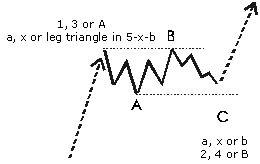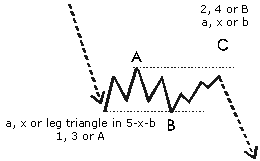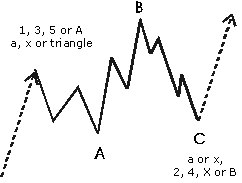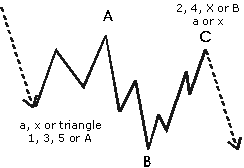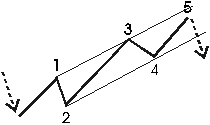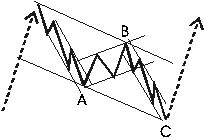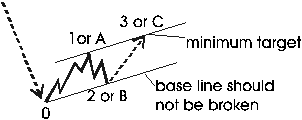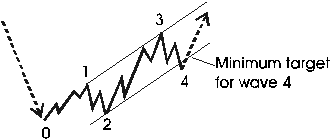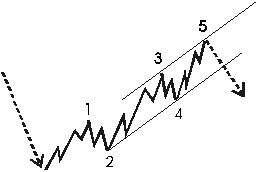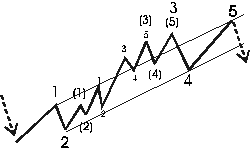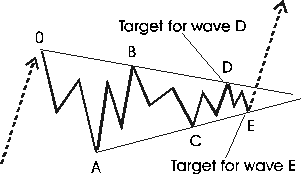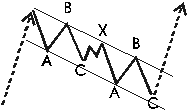1. General :: top :: | ||||||||||||||||||||||||||||||||||
| The Elliott Wave principle was discovered in the late 1920s by Ralph Nelson Elliott. He discovered that stock markets do not behave in a chaotic manner, but that markets move in repetitive cycles, which reflect the actions and emotions of humans caused by exterior influences or mass psychology. Elliott contended, that the ebb and flow of mass psychology always revealed itself in the same repetitive patterns, which subdivide in so called waves. In part Elliott based his work on the Dow Theory, which also defines price movement in terms of waves, but Elliott discovered the fractal nature of market action. Thus Elliott was able to analyse markets in greater depth, identifying the specific characteristics of wave patterns and making detailed market predictions based on the patterns he had identified. Fractals are mathematical structures, which on an ever smaller scale infinitely repeat themselves. The patterns that Elliott discovered are built in the same way. An impulsive wave, which goes with the main trend, always shows five waves in its pattern. On a smaller scale, within each of the impulsive waves of the before mentioned impulse, again five waves will be found. In this smaller pattern, the same pattern repeats itself ad infinitum (these ever smaller patterns are labeled as different wave degrees in the Elliott Wave Principle) Only much later were fractals recognized by scientists. In the 1980s the scientist Mandelbrot proved the existence of fractals in his book "the Fractal Geometry of Nature". He recognized the fractal structure in numerous objects and life forms, a phenomena Elliott already understood in the 1930s. In the 70s, the Wave Principle gained popularity through the work of Frost and Prechter. They published a legendary book ( a must for every wave student) on the Elliott Wave (Elliott Wave Principle...key to stock market profits, 1978), wherein they predicted, in the middle of the crisis of the 70s, the great bull market of the 1980s. Not only did they correctly forecast the bull market but Robert R. Prechter also predicted the crash of 1987 in time and pinpointed the high exactly. Only after years of study, did Elliott learn to detect these recurring patterns in the stock market. Apart from these patterns Elliott also based his market forecasts on Fibonacci numbers. Everything he knew has been published in several books, which laid the foundation for people like Bolton, Frost, Prechter and the professional traders who designed this Elliott Wave software, to make profitable forecasts, not only for stock markets, but for all financial markets. Next let?s first examine the patterns Elliott identified. | ||||||||||||||||||||||||||||||||||
2. Basic Theory :: top :: | ||||||||||||||||||||||||||||||||||
| According to physical law: "Every action creates an equal and opposite reaction". The same goes for the financial markets. A price movement up or down must be followed by a contrary movement, as the saying goes: "What goes up must come down"( and vice versa). Price movements can be divided into trends on the one hand and corrections or sideways movements on the other hand. Trends show the main direction of prices, while corrections move against the trend. In Elliott terminology these are called Impulsive waves and Corrective waves. The Impulse wave formation has five distinct price movements, three in the direction of the trend (I, III, and V) and two against the trend ( II and IV).
Obviously the three waves in the direction of the trend are impulses and therefore these waves also have five waves. The waves against the trend are corrections and are composed of three waves.
The corrective wave formation normally has three, in some cases five or more distinct price movements, two in the direction of the main correction ( A and C) and one against it (B). Wave 2 and 4 in the above picture are corrections. These waves have the following structure:
Note that these waves A and C go in the direction of the shorter term trend, and therefore are impulsive and composed of five waves, which is shown in the picture above. An impulse wave formation followed by a corrective wave, form an Elliott wave degree, consisting of trend and counter trend. Although the patterns pictured above are bullish, the same applies for bear markets, where the main trend is down. The following example shows the difference between a trend (impulse wave) and a correction (sideways price movement with overlapping waves). It also shows that larger trends consists of (a lot of ) smaller trends and corrections, but the result is always the same.
Very important in understanding the Elliott Wave Principle is the basic concept that wave structures of the largest degree are composed of smaller sub waves, which are in turn composed of even smaller sub waves, and so on, which all have more or less the same structure ( impulsive or corrective) like the larger wave they belong to.
In theory the number of wave degrees are infinite, in practice you can spot about four more wave degrees if you examine at tick charts. This indicates that you can trade the investment horizon, which is most suited for you, from very aggressive intra day trading to longer term investing. The same rules and patterns apply over and over again. Now we will take a look at the patterns...
| ||||||||||||||||||||||||||||||||||
3. Patterns :: top :: | |||||||||||||||||||||||||||
| Studying the patterns is very important in order to apply the Elliott Wave Principle correctly. The pattern of the market action, if correctly determined, not only tells you to what price levels the market will rise or decline, but also in which way (or pattern) this will happen. When you are able to recognize the patterns, and apply these patterns correctly, you can trade the Elliott Wave Principle. This is not easy to accomplish, but after some study and with the help of the "ELWAVE " tool you will find it easier. Humans, with sufficient experience, can analyse markets in an instance, which is a requirement for trading. ELWAVE restricts itself mainly to the patterns mentioned in the Classic Elliott Wave patterns. These patterns have been programmed in our Classic Rules version. In our Modern Rules version, as mentioned under Modern Elliott Wave patterns, we have defined more patterns, which we have found after more than 10 years of research and experience, which definitions are more profitable in our view. This way we make available our knowledge and experience without any extra costs. It is up to the user to determine which rules are preferable. We think it is important that the user has the opportunity of using his preferred set of rules. Explaining the following descriptions, on the left you will find a picture of a bull market, at the right one of a bear market. The pattern section depicts the structure, while the description gives additional information. The pattern should follow the rules and guidelines, which can also be derived from the picture. Furthermore the section, in which wave explains in which wave, as a part of a larger wave degree, the patterns normally occur. Last but not least the pattern must have an internal structure as described. This is very important to determine which pattern you are dealing with. | |||||||||||||||||||||||||||
| Below we have depicted all Elliott Wave patterns that are allowed under a very strict interpretation of the Elliott Wave Principle. Elliott detected most of these patterns, except for the Diagonal 2 pattern. The WXY and WXYXZ pattern have not been defined as such by Elliott, but he already had discovered these sort of combinations. In our Automatic analysis engine we use the WXY and WXYXZ also for Double and Triple Zigzags. This is a much more consistent way of labeling these patterns, since now the ABC waves in waves W and Y are sub waves and an unfitting Wave X has been eliminated. Because of this the Automatic analysis no longer has to search for more than five waves. Using the old definition of for example a Triple Zigzag, the search was for eleven waves, apart from inconsistencies this would have slowed down the analysis considerably. a. Impulse Pattern Description Impulses are always composed of five waves, labeled 1,2,3,4,5. Waves 1, 3 and 5 are themselves each impulsive patterns and are approximately equal in length. Waves 2 and 4 on the contrary are always corrective patterns. Rules and guidelines The most important rules and guidelines are:
In which wave Impulse patterns occur in waves 1, 3, 5 and in waves A and C of a correction( this correction could be a wave 2, 4 or a wave B, D, E or wave X). Internal structure It is composed of five waves. The internal structure of these waves is 5-3-5-3-5. Note that the mentioned 3s are corrective waves, which should be composed of 5 waves in a corrective triangle. b. Extension Pattern
Description By definition an extension occurs in an impulsive wave, where waves 1, 3 or 5 can be extended, being much longer than the other waves. It is quite common that one of these waves will extend, which is normally the third wave. The two other waves then tend to equal each other. In our pattern definitions we call it an Extension1 if the first wave extends, an Extension3 if the 3rd wave extends and an Extension5 if the 5th wave extends. Rules and guidelines The most important rules and guidelines concerning an extended wave are:
In which wave Extensions occur in waves 1, 3, 5, and in A and C waves, when compared to each other. Internal structure As a minimum it is composed of 9 waves, though 13 or 17 waves could occur. So the minimal internal structure of the 9 waves is 5-3-5-3-5-3-5-3-5. Note that the 3s mentioned are corrective waves, which could be composed of 5 waves in the case of a corrective triangle. c. Diagonal triangle type 1 Pattern
Description Diagonals are sort of impulsive patterns, which normally occur in terminal waves like a fifth or a C wave. Don?t confuse them with corrective triangles. Diagonals are relatively rare phenomena for large wave degrees, but they do occur often in lower wave degrees on intra-day charts. Usually Diagonal triangles are followed by a violent change in market direction. Rules and guidelines The most important rules and guidelines are:
In which wave Diagonal triangles type 1 occur in waves 5, C and sometimes in wave 1. Internal structure The internal structure of the five waves is 3-3-3-3-3. d. Diagonal triangle type 2 Pattern
Description Diagonal type 2 is a sort of impulsive pattern, which normally occurs in the first or A wave. The main difference with the Diagonal Triangle type 1 is the fact that waves 1, 3 and 5 have an internal structure of five waves instead of three. Experience shows it can also occur in a wave 5 or C, though the Elliott Wave Principle does not allow this. Don?t confuse this with corrective triangles. Diagonals are relatively rare phenomena for large wave degrees, but they do occur often in lower wave degrees in intra day charts. These Diagonal triangles are not followed by a violent change in market direction, because it is not the end of a trend, except when it occurs in a fifth or a C wave. Rules and guidelines The most important rules and guidelines are:
In which wave Diagonal triangles type 2 occur in waves 1 and A. Internal structure The five waves of the diagonal type 2 show an internal structure of 5-3-5-3-5. e. Failure or Truncated 5th Pattern
Description A failure is an impulsive pattern in which the fifth wave does not exceed the third wave. Fifth waves, which travel only slightly beyond the top of wave 3, can also be classified as a kind of failure. It indicates that the trend is weak and that the market will show acceleration in the opposite direction. Rules and guidelines The most important rules and guidelines are:
In which wave A failure can only occur in a fifth wave or a C wave, but normally not in the fifth wave of wave 3. Internal structure It must be composed of five waves. II. Corrections :: top :: a. Zigzag Pattern
Description A Zigzag is the most common corrective structure, which starts a sharp reversal. Often it looks like an impulsive wave, because of the acceleration it shows. A zigzag can extend itself into a double or triple zigzag, although this is not very common, because it lacks alternation (the same two patterns follow each other). Notice that the zigzag can only be the first part of a corrective structure. Rules and guidelines
In which wave Most of the time it happens in A, X or 2. Also quite common in B waves as a part of a Flat, (part of) Triangles and sometimes in 4. Internal structure A single Zigzag is composed of 3 waves, a double of 7 waves separated by an X wave in the middle, a triple of 11 waves separated by two X waves (see pictures below). The internal structure of the 3 waves is 5-3-5 in a single Zigzag, 5-3-5-3-5-3-5 in a double. Example of a Double Zigzag
As you have noticed we have a more modern representation of the Double Zigzag using the labels WXY instead of ABCXABC. This is more consistent, since this way 2 zigzags of lower degree get connected to each other by waves of higher degree. On top if that, our automatic analysis needed such a consistent method of labeling to reach maximum performance. Instead of labeling 7 waves (ABCXABC), the Automatic analysis needs to label only 3 waves (WXY). According to the same method a Triple Zigzag is represented by WXYXZ instead of ABCXABCXABC. This way the number of waves was reduced to five instead of eleven. b. Flat Pattern
Description Flats are very common forms of corrective patterns, which generally show a sideways direction. Waves A and B of the Flat are both corrective patterns. Wave C on the contrary is an impulsive pattern. Normally wave C will not go beyond the end of wave A. Rules and guidelines
In which wave It occurs mostly in B waves, though also quite common in 4 and 2. Internal structure As mentioned before a Flat consists of 3 waves. The internal structure of these waves is 3-3-5. Both waves A and B normally are Zigzags. c. Expanded Flat or Irregular Flat Pattern
Description This is a common special type of Flat. Here the B wave is extended and goes beyond the (orthodox) end of the previous impulsive wave. The strength of the B wave shows that the market wants to go in the direction of B. Often a strong acceleration will take place, which starts a third wave or an extended fifth. If the C wave is much longer then A, the strength will be less. Rules and guidelines
In which wave This corrective pattern can happen in 2, 4, B and X. If it happens in 2 and C is relatively short, normally an acceleration in the third will take place. Internal structure It is composed of five waves, which have an internal structure of 3-3-5. d. Triangles Contracting Triangle: Pattern
Description A triangle is a corrective pattern, which can contract or expand. Furthermore it can ascend or descend. It is composed of five waves, each of them has a corrective nature. Rules and guidelines
In which wave Triangles occur only in waves B, X and 4. Never in wave 2 or A. Internal structure It is composed of five waves, of which the internal structure is 3-3-3-3-3.
Expanding Triangle:
Ascending Triangle: This is a triangle, which slopes upwards. This pattern has been implemented in the Modern Rules.
Descending Triangle: This is a triangle, which slopes downwards. This pattern has been implemented in the Modern Rules.
Running Triangle: This is a triangle where the B wave exceeds the origin of wave A. e. WXY or Combination Many kinds of combinations are possible. Below a rather complex example has been depicted. Pattern
Description A Combination combines several types of corrections. These corrections are labeled as WXY and WXYXZ if it is even more complex. It starts for example with a Zigzag (wave W), then an intermediate X wave, then a Flat (wave Y) and so on. A so-called double or triple three is also a Combination, but this pattern combines Flats separated by X waves. Rules and guidelines
In which wave Generally a Combination occurs mostly in B, X and 4, it is less common in A and rare in 2. Internal structure For example a Zigzag, followed by a Flat, followed by a Triangle has the following internal structure: 5-3-5(Zigzag)-5-3-5(X)-3-3-5(Flat)-3-3-3-3-3(Triangle).
f. Running Flat Pattern
Description The Running correction is a rare special form of a failure. This pattern is a kind of Flat, with an elongated B wave and a very small C wave. According to theory wave C should be so short that it doesn?t get to the price territory of wave A. ELWAVE does not except a C wave that fails to reach the price territory of wave A. Instead of a running correction this could in theory be an extension in an impulsive wave, where the wave has subdivided in two (or more) 1,2 combinations. If the B is a clear three wave, then it is a Running correction, otherwise an extension. In practice there will not be any difference in market direction: in both scenarios the market will explode in the direction of the B wave, therefore ELWAVE prefers to label it as an extension. For the sake of correctness we have included this pattern, it has been implemented in the Classic Rules, not in the Modern Rules. Rules and guidelines
In which wave Most of the time it should occur in wave 2 or B. Internal structure It is a three-wave structure. The internal structure is X wave Description An X wave is an intermediate wave in a more complex correction. This wave is always corrective and can take many forms like a Zigzag, Double Zigzag, Flat, Expanded Flat, combination and a triangle. | |||||||||||||||||||||||||||
| In our Modern Rules engine we have defined extra patterns that are mostly hybrid patterns derived from the known patterns that have existed from the beginning. In addition, we allow for the occurrence of more patterns in some waves. For example, wave 1 may also contain a diagonal1, diagonal2 and impulse 2 pattern, in addition to the other trend patterns, that a classic interpretation accepts. a. Impulse 2 Pattern Description An Impulse 2 is an uncommon pattern that resembles a normal impulse considerably. In our Automatic analysis we allow for a maximum retracement of 51.5% for wave 4 in an impulse or other trend pattern. Of course sometimes the retracement of wave 4 could be 51.6% and an impulse would then be eliminated, in spite of the fact that the limit was exceeded by 0.1% only. Naturally the Elliott Wave does not apply this strictly and the Impulse 2 pattern corrects for this problem. Apart from this, we have witnessed a retracement up to 62% for a wave 4 frequently in intra day charts. Rules and guidelines The same rules and guidelines apply as with a normal impulse except for the following:
In which wave Impulse 2 patterns mostly occur in waves 1,A or C, never in a wave 3! Internal structure It is composed of five waves. The internal structure of these waves is 5-3-5-3-5. Note that the mentioned 3s are corrective waves, which could be composed of 5 waves in a corrective triangle. II. Corrections :: top :: a. ZigzagFlat Pattern
Description It is a common pattern that is exactly the same as a Zigzag, except for the fact that the B wave is allowed to retrace more than 61.8% of wave A. b. Running Zigzag Pattern
Description Apart from contracting Triangles, a failure in a corrective pattern happens when the C wave is shorter than wave A and fails to go beyond the end of A. This mostly happens in Running Flats and or in Zigzags. It indicates strength in the direction of the main trend. Rules and guidelines
In which wave Failures can occur in a C wave of wave 2, in a C or E wave of wave 4, in a C wave of wave B or X. c. Failed Flat Pattern
Description This pattern is exactly the same as a Flat, except for the fact that wave C does not reach the end of wave A and therefore is shorter than wave B. d. Running Flat (modern) Pattern
Description This pattern is exactly the same as a Running Flat, except for the fact that it must retrace more than 60%, if not ELWAVE considers it to be a normal Running Flat. This distinction is necessary, because normally a Running Flat is rare. But if it retraces more than 60% and still fails to reach the end of wave A, it suddenly becomes a much more probable the pattern will occur. In which case it will get a much higher score. e. Ascending and descending Triangles Description These are mentioned under the Triangles description in the Classic patterns section. Basically these patterns are the same as common contracting triangles, except for the fact that ascending and descending triangles slope up or down.
| |||||||||||||||||||||||||||
